History of Russia
Andrey Rublev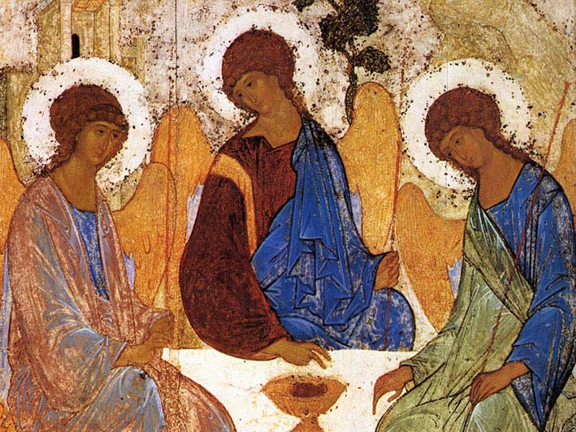
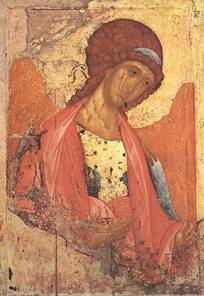 Andrey Rublev's name aroused a lot of
legends, and in 20 century - a lot of scientific hypotheses. The real
ideas about his art appeared only after the restorational clearing of
his icon "Trinity" in 1904, but to the fullest - since 1918 when the
frescos of Uspensky cathedral in Vladimir had been cleared and icons
from Zvenigorod were found
Andrey Rublev's name aroused a lot of
legends, and in 20 century - a lot of scientific hypotheses. The real
ideas about his art appeared only after the restorational clearing of
his icon "Trinity" in 1904, but to the fullest - since 1918 when the
frescos of Uspensky cathedral in Vladimir had been cleared and icons
from Zvenigorod were foundHe was accepted in monks at that place (by the another hypothesis - in Andronikov monastery in Moscow). In 1408, as it is written in the chronicles, together with Daniel Chernyi he painted the ancient (12 century) Uspensky cathedral in Vladimir; and he was considered to be the second after Daniel.
In 1420 according to the certificate «Live of Sergy Radonezhsky» (the edition of Epifanyi the Wise and Pahomy Serb) and «Live of Nikon» ( the certificate of 1430-50) - both masters painted the church of the saint Trinity in Troitsk monastery, constructed instead of old wooden one (1411) in 1423-24 above the coffin of Sergy Radonezhsky. After the death of Daniel, buried in Troitsk monastery, Andrey Rublev came back to Moscow in Andronikov monastery where he made his last work - the painting of a church Spasa (was started about 1426-27 and finished about 1428). He died on January 29th in 1430 in Andronikov monastery (the date was established by D.Baranovsky according to the copy (18th century) of the inscription on the lost tombstone)
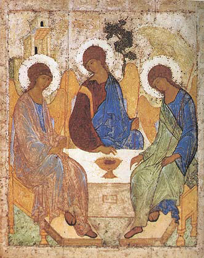 There are very few of Andrey Rublev`s
works left which were specified in the chronicles: the frescos in
Uspensky cathedral in Vladimir and the well-known icon "Trinity" from
Troitsky iconostasis in cathedral of Troitsky monastery. From two dates
of the writing of the "Trinity", offered by chronicles, - 1411 and
1425-27 - the last one seem to be more probable. Other works mentioned
in the certificates, either were not kept, or belong not to Andrey
Rublev but to his apprentices - the members of the artel
headed by Daniel Chernyi and Andrey Rublev (iconostasises of Uspensky
cathedral in Vladimir and Troitsky cathedral in Troitsky monastery).
There are very few of Andrey Rublev`s
works left which were specified in the chronicles: the frescos in
Uspensky cathedral in Vladimir and the well-known icon "Trinity" from
Troitsky iconostasis in cathedral of Troitsky monastery. From two dates
of the writing of the "Trinity", offered by chronicles, - 1411 and
1425-27 - the last one seem to be more probable. Other works mentioned
in the certificates, either were not kept, or belong not to Andrey
Rublev but to his apprentices - the members of the artel
headed by Daniel Chernyi and Andrey Rublev (iconostasises of Uspensky
cathedral in Vladimir and Troitsky cathedral in Troitsky monastery).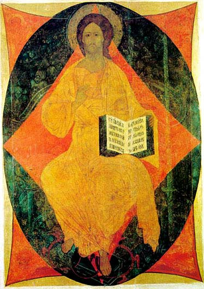 8) some icons from
Deisus of Troitsky cathedral in Troitsky monastery and one of it`s
Celebratory raw ("Christening"), about 1428; 9) a small icon
« Spas v silah» - at the beginning of 15 century
(the State Tretjakovskaja gallery). From all that was listed we can be
sure that only the following works belong to Andrey Rublev: miniatures
of gospel Hitrovo, Zvenigorod icon and the icon " Mother of god
"Umilenie" from Vladimir, and also - probably - the frescos in Uspensky
cathedral in Gorodok.
8) some icons from
Deisus of Troitsky cathedral in Troitsky monastery and one of it`s
Celebratory raw ("Christening"), about 1428; 9) a small icon
« Spas v silah» - at the beginning of 15 century
(the State Tretjakovskaja gallery). From all that was listed we can be
sure that only the following works belong to Andrey Rublev: miniatures
of gospel Hitrovo, Zvenigorod icon and the icon " Mother of god
"Umilenie" from Vladimir, and also - probably - the frescos in Uspensky
cathedral in Gorodok.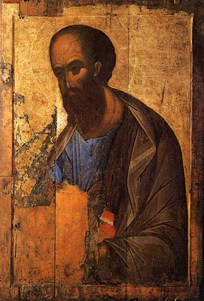
Images of Andrey Rublyov as a whole are adequate to images of the Byzantian art about 1400 year and first thirds of 15 century, but differ from them with their greater mildness and humility; there is nothing from aristocratic nobleness and intellectual dignity in them, which were praised by the Byzantian art, but the preference is given to modesty and simplicity. Faces are Russians, with medium-sized features, without underlined beauty, but always light, comely
Classical feeling of a composition, rhythms, each separate form, made in clearness, harmony, plastic perfection, of Andrey Rublev is so irreproachable as at the Greek masters of first third of 15 century. But to add to this, sometimes Andrey Rublev soften a little the features of classical system: roundity of the form is not emphasized, illusion moments are absent (for example, anatomically true transfering of joints), owing to that volumes and surfaces seem changed, - as well as in the Byzantian art, every form at Andrey Rublev appears to be changed, spiritualized with Divine energy. It is was achieved by the techniques, which are general for all Byzantian art: laconic contours and silhouettes giving weightlessness to the figures ; closed parabolic lines which make the thoughts be focused and adjusted to contemplation; thin outlines of folds of the clothes, adding fragility to the materials; the light saturation of each color making the colour shine, etc. However Andrey Rublev changed these general Byzantian features of style of early 15 century, because the ideal classical forms, habitual for the Greek masters since antique times, were not value for him. Besides, to the qualities peculiar to all Byzantian art, Andrey Rublev added features, characteristic of Russian art of the end 14 - the beginning of 15 centuries: lines became smooth, rhythms - musical, turns of figures and their heads - soft, cloths - airly, colourful scale - light and gentle. In everything was shine harmony of Paradise and simultaneously - disposition to the person, kindness.
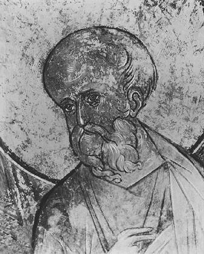 The sources of contemplate depth of
perception of Andrey Rublev are in spiritual situation of the late 14
century - under Sergy Radonezhsky, and of the early 15 century - under
his apprentices. It was the time of high dissemination of isihazm in
Byzantium, which got the wide support in Russia. The intonation of
paradise harmony penetrating the artistic career of Andrey Rublyov is
characteristic of art of all Christian world of the first half of 15
century - Byzantium (frescos of Pantanass in Mistr, about 1428), Serbia
(frescos of Manasija before 1418 and Kalenich about 1413), the Western
Europe (Gentsky altar of Yan Van Ejk, 1432; works of Fra Beato
Andzheliko).
The sources of contemplate depth of
perception of Andrey Rublev are in spiritual situation of the late 14
century - under Sergy Radonezhsky, and of the early 15 century - under
his apprentices. It was the time of high dissemination of isihazm in
Byzantium, which got the wide support in Russia. The intonation of
paradise harmony penetrating the artistic career of Andrey Rublyov is
characteristic of art of all Christian world of the first half of 15
century - Byzantium (frescos of Pantanass in Mistr, about 1428), Serbia
(frescos of Manasija before 1418 and Kalenich about 1413), the Western
Europe (Gentsky altar of Yan Van Ejk, 1432; works of Fra Beato
Andzheliko).Andrey Rublyov's artistic career marked the blossoming of national school of Russian painting in 15 century, beeing original in comparison with Byzantium. It had the great influence on all Russian Moscow art till Dionisy.
On our pages you can make the travel to history Russia , and to the history Moscow and S-Peterburg
recommended
sites:
 Internet
shop
of excusive Russian souvenires "ATAMAN".
Internet
shop
of excusive Russian souvenires "ATAMAN".
If you want to present a spesial gift to your relatives or friends,
want to get really unforgettable memory about your trip or you are
interested in the history of russia - this shop
is a real find for you
There are history maps, books, souvenires, insignia, heraldry and many
other things on this site. This site have the English
version.
You can find the link for it in the right top corner of the site
We hope that the information of our portal will be useful to you.
